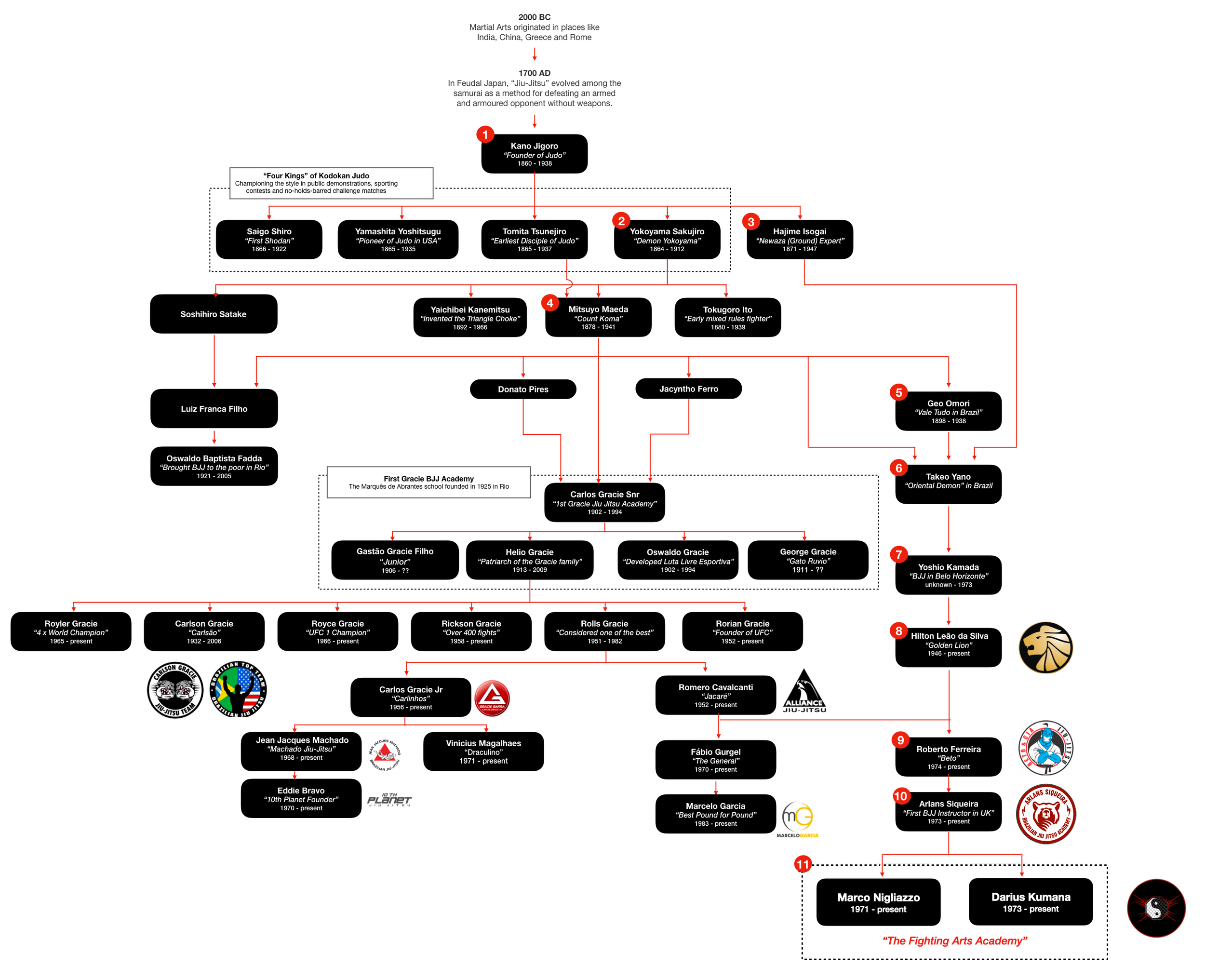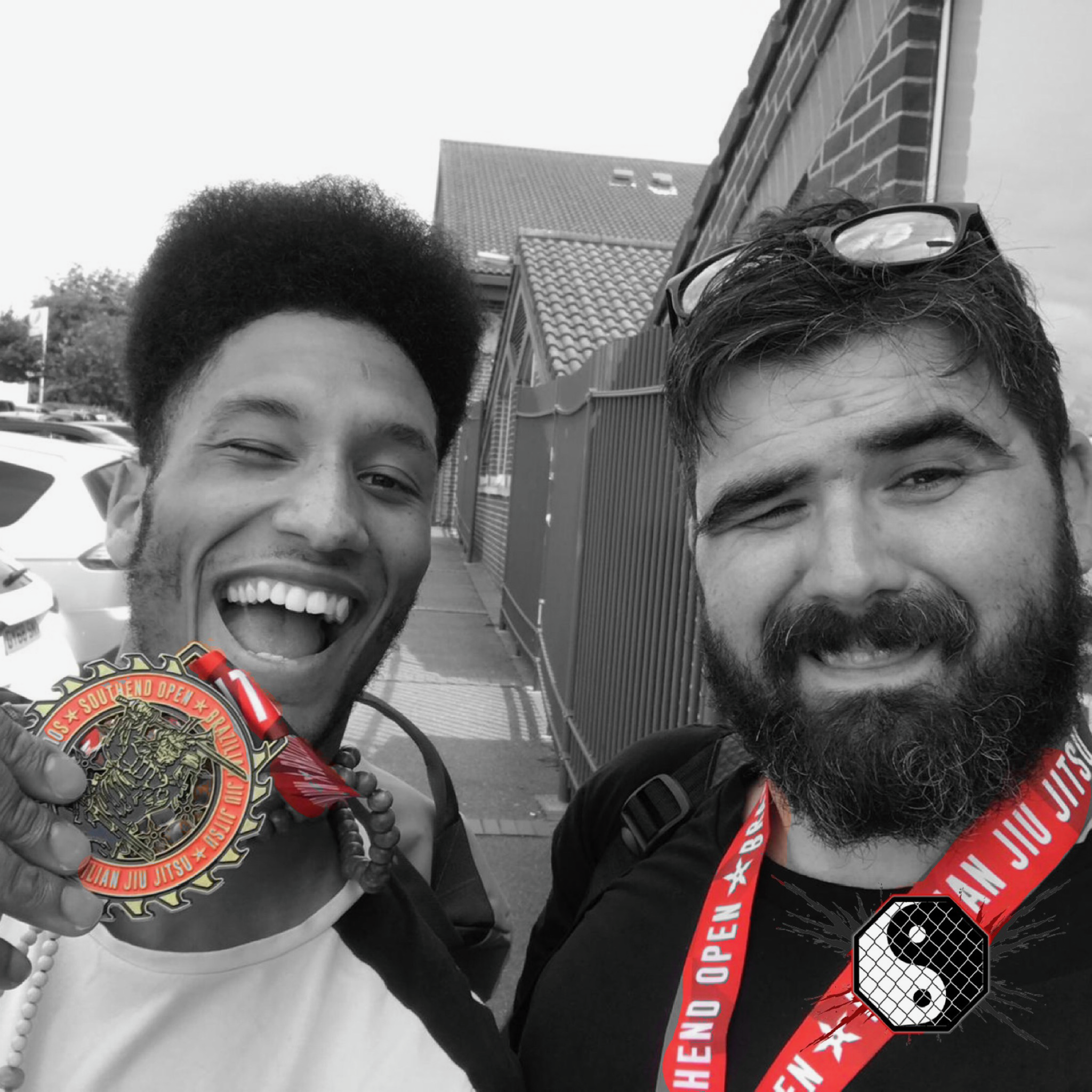Grappling Heritage
There can be quite a lot of confusion when it comes to heritage and lineage within the Martial Arts. Brazilian Jiu-Jitsu is a comparative new-comer to the worlds stage where it’s popularity skyrocketed when Royce Gracie used the art to win the first ever Ultimate Fighting Championship back in 1993.
Although there is little doubt that BJJ has become one of the most effective combat arts in the world, there is often confusion as to where these grappling arts originated and what constitutes “real” BJJ...
Questions like - “When/how exactly did Jiu-Jitsu / Judo move from Japan to Brazil and become Brazilian Jiu-Jitsu? or “How does Gracie Jiu-jitsu (made famous through Helio Gracie and his family) fit in with your history?”
Whilst interesting academic questions for historians - these questions can sometimes be unhelpful as they can cause unnecessary rifts between proponents of the art.
At The Fighting Arts Academy - we are keen to promote authentic Brazilian JiuJitsu and grappling - regardless of its origins. The beautiful thing about our sport is that it is regularly battle-tested so there is little doubt of the style’s efficacy. We are also keen to encourage evolution within the sport so are keen to teach evolving techniques such as leg-locks (which are often frowned upon by traditionalists) to our advanced students.
For the historians amongst you, the following diagram should give you an idea of where our jiujitsu comes from. We know that our Jiujitsu at The Fighting Arts Academy follows the Arlans Siqueira > Roberto Ferreira > Hilton Leao Da Silva > Yoshio Kamada > Takeo Yano lineage line. Before Takeo Yano things become a little less clear as there are multiple potential routes down from Kano Jigoro.
1) Kano Jigoro
Kanō Jigorō (嘉納 治五郎) was a Japanese educator and athlete, the founder of Judo.
Judo was the first Japanese martial art to gain widespread international recognition, and the first to become an official Olympic sport. Well-known mottoes attributed to Kanō include "maximum efficiency with minimum effort" (精力善用 seiryoku zen'yō)
2) Yokoyama Sakujiro
Yokoyama Sakujirō (横山 作次郎, 1864 – September 23, 1912), was one of the earliest disciples of Kanō Jigoro. He was considered the most formidable of all judo experts of his time, which reflected in his nickname of "Demon Yokoyama" (鬼横山 Oni Yokoyama).
3) Hajime Isogai
Hajime Isogai (磯貝 一 Isogai Hajime, October 26, 1871 – April 19, 1947) was an early student of Judo and . He was considered to be a "newaza" (Ground Grappling Techniques) expert. He was an early promoter of the kosen judo circuit. On December 22 1937, he became the second person to be awarded the 10th dan grade and the first living person to be presented with it.
4) Mitsuyo Maeda
A Brazilian naturalised as Otávio Maeda was a Japanese judōka and prizefighter in no holds barred competitions, also being one of the first documented mixed martial artists of the modern era for he frequently challenged practitioners of other arts and sports.
He was also known as Count Combat or Conde Koma in Spanish and Portuguese, a nickname he picked up in Spain in 1908. He pioneered judo in Brazil, the United Kingdom, and other countries.
5) Geo Omori
Jyoji Omori (1898–1938) or Geo Omori as he became known in Brazil, was a Japanese-born Brazilian martial artist who is credited for being one of the creators of Brazilian Jiu Jitsu. Born in Tokyo, Omori joined the Kodokan school in 1907 at age 9 and gained his black belt in 1915 at age 17.
He learned under Tokugoro Ito and was a training partner of the famed Sanpo Toku. After moving to Brazil in 1925, he taught Jiu Jitsu and Judo in Rio de Janeiro, and in 1931 he opened a school in São Paulo. Omori is considered instrumental in the foundation of Brazilian Jiu-Jitsu by establishing the first Jujitu school in São Paulo. Omori was one of the first prominent mixed martial arts competitors of his era. He helped to initiate the Vale Tudo trend of the 1920s and 1930s in Brazil. Geo had an extensive fight history engaging fighters of various styles including capoeira, boxing, and wrestling. He fought many members of the Gracie family including George Gracie and Carlos Gracie.
6) Takeo Yano
Takeo Yano was a Japanese judoka who helped in the establishment of Brazilian jiu-jitsu in Brazil. Yano was a standout in judo, learning it in the Dai Nippon Butoku Kai under the renowned Hajime Isogai. He worked with the Ono brothers, Yasuichi and Naoichi. They taught at Judo North of Brazil.
He also taught in São Paulo and Rio de Janeiro. In 1937, Yano fought Hélio Gracie to a draw. As a fighter he took on the name ″Oriental Demon″.
Yano is thought to have introduced the heel hook into Brazilian Jiu-Jitsu.
7) Yoshio Kamada
In July 1934, a Japanese judoka Yoshio Kamada arrives in Brazil. in 1953, in the city of Belo Horizonte, he began teaching Judo at Mineira Tennis Club.
Yoshio was an expert in massage therapy, agriculture and martial arts, having an 8th Dan Judo degree.
8) Master Hilton Leao da Silva
Hilton Leão da Silva (born April 11, 1946) is an 9th Degree Red Belt in Brazilian jiu-jitsu.
He is the actual president of Liga Brasileira de Jiu-Jitsu and also the head of Leão Dourado Brazilian jiu-jitsu Association in Belo Horizonte, Brazil. Having originally achieved his black belt in Brazilian jiu-jitsu in 1975.
Master Hilton Leão is still an avid practitioner of the art. In 2008, at 62 years old, he fought Célio Caneca on the International Masters & Seniors of Jiu-Jitsu. 2008 also saw him receive his 8th Degree in jiu-jitsu by president of Federação Mineira de Jiu-Jitsu, Adair Alves de Almeida.
In 1975, he competed in a Tournament for the Foundation of the Mining Federation of Jiu-Jitsu, and won the "Absolute Champion of Vale-Tudo" title. There were five fights and he achieved five victories, competing with several champions from other martial arts. The referee of these fights was Grand Master Hélio Gracie, who came especially from Rio de Janeiro for this event.
Leão Dourado means golden lion in Portuguese.
9) Professor Roberto Ferreira (Beto)
In 1993, Professor Roberto Ferreira (Beto) received his black belt from FMJJ (Federação Mineira de Jiu-Jitsu). The following year, a small class gained popularity and as a consequence, the Wall Street Fitness Academy coached by Beto soon opened its doors.
This collaboration between the Wall Street Fitness Academy and the Leão Dourado Sports Association saw Professors Roberto Ferreira (Beto) and Hunderson Cláudio build a team under the supervision of Master Hilton Leão da Silva.
This team became the undefeated Adult Champions of the Mineira Championship of 1995.
Beto affiliated with Alliance under Romero “Jacare” Cavalvanti but in 1996, Professor Roberto Ferreira (Beto) founded his own team - BETO & CIA
In 2012 he was honoured by the Mayor of Belo Horizonte for his services to jiujitsu. In 2015, he was awarded his 5th Degree by Master Hilton Leao himself. In 2018, he received his 6th Degree.
10) Professor Arlans Siqueira
At the age of 16 Arlans began learning Jiu Jitsu under Professor Roberto Ferreira (then with Leao Dourado). Later he also trained under Professor Vinicius "Draculino" Magalhaes from Gracie Barra.
Arlans Siqueira arrived in London UK on 13th May 1997 with a single suitcase containing little more than a Jiujitsu Gi and a Brown Belt. He began teaching in his Tottenham and Seven Sisters academy in 1997 and is widely credited with being the first person to teach Brazilian Jiu Jitsu in the UK.
All this just 4 years after Royce Gracie made headlines with the art by winning the first ever Ultimate Fighting Championship.
As his family responsibilities grew, Arlans continued his own personal training but took a break from teaching.
In 2007, Arlans re-established his Academy in the UK and has taken the teaching circuit by storm. For over 20 years he has maintained a very high standard of teaching ranging from beginners to advanced competitors. Over the years Arlans has put together a team of expert instructors – all trained to the highest standards of jiu-jitsu. He has several senior students (including several black-Belts) who all teach at Arlans Siqueira affiliated academies. Arlans was was recently awarded the 4rd degree on his black belt by Roberto Ferreira. More about Arlans Siqueira Brazilian Jiu-Jitsu.
11) The Fighting Arts Academy Coaches
Marco and Darius are lead grappling coaches at The Fighting Arts Academy.
They were both awarded black belts by their coach Arlans Siqueira.
They are supported by their brown-belts Dave, Andrew, as well as purple-belts Dawood, Sam, Wayne and Pete as well as a host of other assistant coaches.
The Fighting Arts Academy's grappling is affiliated with Arlans Siqueira Brazilian Jiujitsu and is recognised by the IBJJF.
As a mixed-martial arts club, we continue to evolve across multiple dimensions. Our strong gi-based grappling foundation provides the bedrock of the jiujitsu we teach. For those wishing to compete in no-gi and the modern leg-lock game coach Andrew from 50/50Lockers provides expertise. This is further enhanced through our specialist no-gi coach, 50/50 Lockers Sponsored Athlete and Elite-Level 10th Planet Competitor – Mattia. Grappling at The Fighting Arts Academy is a perfect compliment to the expert striking and Muay Thai instruction provided at the Academy.









































